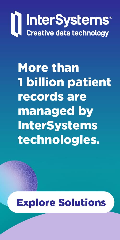EPtalk by Dr. Jayne 6/15/23
I recently took a smaller version of The Great American Road Trip and made it a point to visit some historical roadside attractions. In the 1950s, it was all about seeing the USA in your Chevrolet (or equivalent) and families might have stopped at various quirky museums or points of interest.

One of the places I visited had a collection of antique cars. I was struck by the idea of this 1960s era Amphicar. In some ways it’s a solution in search of a problem, which is something we see often in the world of healthcare IT. I have so many vendor emails hit my box each week promising to solve problems that I didn’t even know I had that I can’t keep track of them all.
The Amphicar was innovative, but didn’t make it big, ceasing production only four years after it began. Sounds like a lot of the products I see out there.
A group of organizations including AstraZeneca, Elevance Health, Geisinger, and UCSF have come together to publish a framework for evaluating digital health products. The goal is for care delivery organizations, health insurers, and trade groups to use it to determine whether digital health products are evidence based. The authors examined 70 frameworks that were created to assess the evidence around digital health intervention, determining that the existing frameworks lacked the specificity needed by healthcare organizations.
Sometimes people forget that digital health interventions can be as important and useful to patients as medications and surgeries. For example, an appropriate intervention to help patients stop smoking can prevent lung cancer. Digital coaching to manage body weight can lead to reductions in heart disease and stroke. The authors identified certain requirements as being potentially non-negotiable for organizations depending on their needs: HIPAA compliance, FDA clearance, and ability to be understood by patients with a fifth-grade reading level were examples.
Organizations are instructed next to use existing evidence assessment frameworks that have been defined for non-digital interventions. Following that, they should apply the new framework’s 21-item supplementary checklist for considerations specific to digital health. These may include elements such as assessing an intervention for selection biases, looking at data gaps, or ensuring that underserved patients were included in the product’s clinical trials.
According to the article, there are 300,000 health apps and 300 wearables in the marketplace, so being able to determine quality of an intervention is key. I wonder how much traction this approach will get, especially when we’re already struggling to make use of evidence quality in non-digital interventions. One of the hottest topics among physicians in my area is the surge in providers offering non-evidence-based hydration and vitamin infusion services. Comments such as “the patients want it, and I don’t see the harm” win the day, along with the potential for revenue. I’ll be watching closely to see how the world of evidence for digital interventions plays out.
Mayo Clinic is planning a $1 billion expansion and its new clinical spaces will incorporate data from patient wearables. Clinicians will have the opportunity interact with patient data elements such as pulse, steps, and sleep. I got a chuckle out of the fact that the article specifically called out Mayo’s “marble-filled lobby” since so many hospitals are overly proud of their non-patient-care spaces while patients may struggle to have basic needs met.
I also found it interesting that it mentioned the tension between Mayo’s lobbyist and Governor Tim Walz over the potential for penalties against hospitals that have excessive cost growth. The project is part of Mayo’s plans to transform the city into an international medical hub. The system has pitched the state, county, and city for $500 million in public funding for campus-serving infrastructure improvements. The new expansion will impact several blocks in downtown Rochester and is intended to make the campus more streamlined and modern, eliminating wayfinding confusion and harmonizing the patient experience. Construction is slated to begin in 2024.
Northwell Direct has inked a deal with the US State Department to offer telehealth consultations to patients seeing Department of State medical professionals around the world. The offering will apply to US government employees and their families posted outside the US. Consultations will be available 24 hours a day, seven days a week and requests will be triaged for assignment to the appropriate Northwell provider staff in more than 100 specialties and subspecialties. Those providers will also provide medical clearance services before employees are sent outside the US, as well as clinical case reviews. Northwell Health also partners within the US with Teladoc for additional virtual care delivery services, so it’s not entirely clear how this will all fit together.
Speaking of government, the Surgeon General of the United States has issued an advisory about the impacts of social media on adolescent and child mental health. The report notes that social media use is nearly universal in those ages 13 to 17 with nearly two-thirds reporting daily social media use and one-third reporting use of platforms “almost constantly.” It goes on to conclude that “social media presents a meaningful risk of harm to youth” with those spending more than three hours daily facing double the risk of mental health problems as others who spend less time on social media.
The long and short of it is that “we cannot conclude social media is sufficiently safe for children and adolescents” and lists steps that can be taken to reduce the risk of harm in those groups. These include: reaching out for help for those negatively impacted by social media; creating boundaries to balance media use; being selective about what is posted and shared online; and addressing cyberbullying. A short summary is available or you can view the full advisory.
Many of my family physician colleagues are still trying to figure out how to balance their use of telehealth within the context of traditional primary care practice. A recent report from the University of Washington Center for Health and Workforce Studies showed that while there was limited data about how medical assistants participate in the telehealth setting, those staffers can transition to virtual roles following additional education and training. Unfortunately, I think a lot of organizations just try to throw people in a role without fully thinking it through. We saw this a decade ago, when practices decided they would just turn their medical assistants into scribes but didn’t think through how to create an appropriate training program or how that role transition might otherwise impact office dynamics.
More on the topic of transitioning historically in-person tasks to virtual caregivers. I was talking with some CMIOs earlier this week about whether they think virtual nursing is going to solve some of their staffing issues. Systems such as Washington-based Providence and Arkansas-based Mercy have already rolled out programs and labeled them as successful, preparing for expansion. Among the group, several were enthusiastic about the idea, and one said their system was in the process of rolling it out using internal resources. However, another said her system was about to sunset the concept because it hadn’t yielded the savings it anticipated. Although that organization’s efforts did dramatically reduce its dependence on travel nurses, those savings were countered by expenditures for hardware and third-party staff management.
Has your organization dipped its toes into the waters of virtual nursing? How is it going? Leave a comment or email me.

Email Dr. Jayne.



















































































Is this HIStalk or Reddit? Hard to tell the difference with the comments being posted.